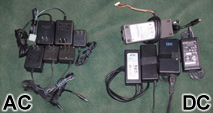Living on DC
March 8, 2010
Archive
Archive
Most of our everyday appliances and electronic devices operate using AC (alternating current), right? … It might surprise you that most appliances we use today are using DC (direct current) rather than AC. Internally they convert the AC to DC. If you’re an electronic hobbyist, you probably already know that. If you’re using a solar system with batteries, you could save by using DC directly.

Reaping the Benefits
The benefits of running things off DC directly is that you have no conversion loss. Inverters and power supplies alike have a conversion efficiency. Most conversion efficiencies lie somewhere between 80-95%. If you can reduce the number of conversions, you will come out ahead. However, it may require you to have ten 12V batteries wired in series to obtain between 110-130 volts DC. You could use a DC-DC converter, but that would defeat the purpose.Distinguishing What Uses AC
First you need to know what you can and can’t operate with DC. You cannot use DC on anything that has a transformer on its power input. You can use these steps as a guideline to determine what can be operated using DC, but the only way to really know is to look inside:- If the appliance has a mechanical switch, turn it on unplugged.
- Use a multimeter to measure ohms (Ω) across the prongs of the plug.
- If the meter reads about 500 ohms or less, it likely uses a transformer.
- Air conditioning and heating systems
- General purpose fans and ceiling fans
- Washing machines/dryers
- Refrigerators/freezers
- Microwave ovens
- Garage door openers
- Fluorescent lights with ballast transformers
- Cell phone chargers (which are usually small wall mount transformers)
- Anything with an AC motor
Distinguishing What Uses DC
You can use DC on anything that has a bridge rectifier on its input. A bridge rectifier is something that converts AC to DC using four diodes. If you can measure around 1 meg ohm (MΩ) or more across the prongs of the plug using a multimeter, it most likely uses a bridge rectifier. Again, the only way to really know is to look inside. Most of the following items use a bridge rectifier or can use AC or DC:- Any lengthwise oriented or switching power supply (doesn’t mount on the wall)
- Computer/Laptop power supplies
- Incandescent, CLF, and LED light bulbs or Christmas lights
- DVD players and newer VCRs
- Game consoles







